The Arts on the Stamps of the World — May 23
An Arts Fuse regular feature: the arts on stamps of the world.

By Doug Briscoe
I’m confused. For reasons that lie outside my circumscribed little pale of comprehension, Pieter Brueghel (or Bruegel or Breughel) the Younger is known to have been born “between 23 May and 10 October 1564,” says Wikipedia. This nice imprecision plus the fact that the painter’s death date is placed “between March and May 1638” offers me little guidance, so I’m going with May 23rd; but my bewilderment is complicated by my admitted confusion vis-à-vis the work of this artist and his namesake father. The question (for an amateur) of who painted what is further muddled by the fact that PB the Younger made many dozens of copies of PB the Elder’s originals. My exhaustive sleuthing has shown that PBtE is the more important figure. (There are many more stamps for Dad than there are for Junior.) I found a Russian stamp of an Adoration of the Magi in the Snow specifically attributed in the Scott stamp catalogue to PBtY, but elsewhere the work is said to be by PBtE, so my assumption is that the stamp shows one of The Younger’s thirty (!) copies of his father’s painting. Similarly the Romanian stamp of Winter landscape with skaters is not to be confused with his Winter landscape with skaters and a bird trap. I guess. This doesn’t even begin to address the matter of PBtY’s brother Jan Brueghel the Elder and nephew Jan Brueghel the Younger. Grist for another mill.
The situation does not measurably improve with Louis Le Nain, whose brothers Antoine Le Nain (c.1599-1648) and Mathieu Le Nain (1607–1677) were painters of note. All three brothers were born near Laon, lived in Paris, and signed their works, some of which may have been collaborations, with their surname only! So the Wikipedia articles (both the English and French versions) lump all three of them together under one heading. Louis, however, who was born about 1593 and died on this date in 1648, is usually credited with the family’s most familiar paintings. Happy Family, a detail of which is seen on the first French Red Cross stamp, is definitely assigned to Louis and dated 1642. The Russian stamp (ditto) offers The Milkmaid’s Family (1641), and the other two French stamps give us different sections of the same painting, Peasant Family in an Interior, which could be by either Louis or Antoine and has an ambiguous dating of “between 1625 and 1648.” German Wikipedia provides three separate articles on the brothers and informs us that Antoine died just two days after Louis. I found one stamp labeled “Antoine” and will show it here on Thursday.
Whether or not the science of taxonomy is an art, the great Swedish botanist and zoologist Carl Linnaeus (23 May 1707 – 10 January 1778) is its progenitor and merits a stamp or two in these pages. (Believe it or not, he had a son, another naturalist, named…Carl Linnaeus the Younger!)

Finally we come to somebody about whom there is no ambiguity, the Italian satirist and poet Giuseppe Parini (23 May 1729 – 15 August 1799). His publication of a book of poems in 1752 earned him election into academies in Milan and Rome. His next effort, Il Giorno (The Day, 1763), was an ironic primer in blank verse for how a young nobleman should spend his time. Its success was such that Parini followed it up with Il Mezzogiorno two years later. It was Parini’s translation of Racine’s Mithridate that served as the basis for a libretto set by the fourteen-year-old Mozart in 1770 (Mitridate re di Ponto). In addition to the stamp for Parini himself, I thought I’d add one showing a high school, originally established in 1774 as the Regio Ginnasio di Brera, that in 1865 was renamed the Liceo Ginnasio Giuseppe Parini Milano.
Another fine artist whose name was heretofore unknown to me is James Pradier, a sculptor who was born (Jean-Jacques Pradier) and grew up in Switzerland, but whose family came from Toulouse and who worked from the age of 17 in France. Pradier (1790 – June 4, 1852) joined his elder brother in Paris in 1807 to learn engraving and began attending the École des Beaux-Arts the next year. He won the Prix de Rome and spent the years 1814 to 1818 studying in the Italian capital. On his return he studied with no less a figure than Ingres and became friendly with Musset, Hugo, Gautier, and Flaubert. Pradier left a substantial amount of very visible work. The figures of Fame in the spandrels of the Arc de Triomphe are his, as are the marble statues of Victory surrounding Napoleon’s tomb at the Invalides. There are the decorative figures at the Madeleine and on the façade of the Palais du Luxembourg. The stamp shows his Sapho (1852), a work that was being displayed when he died. He is buried in Père-Lachaise, where a contemporaneous copy of Sapho marks his tomb.
The Polish writer Maria Konopnicka (ko-nop-NIT-ska; 1842 – October 8, 1910) earned the admiration of Henryk Sienkiewicz with her poem In the Mountains (W górach, 1876). A woman of independent mind, she left her husband, taking her children with her, when he sought to prevent her from pursuing her writing career. It is hardly surprising that she agitated for women’s rights, but she also spoke out against injustice generally, the oppression of Poles and Jews in Prussia and of the poor and the workers everywhere, and wrote a poem—a century after the fact—about the Irish patriot Robert Emmet, who had been executed in 1803 for rebelling against British rule. In addition to her output as a poet, novelist, short story writer, journalist, and critic, she wrote books for children and made translations of Rostand’s Cyrano de Bergerac, poems of Heine, etc. She sometimes wrote under the pen name Jan Sawa.
Hungarian painter József Rippl-Rónai (1861 – 25 November 1927) is credited with introducing modern artistic concepts into the art of Hungary. He learned pharmacology in Budapest and studied art in Munich and Paris, where his teacher was Mihály Munkácsy. In later years, Rippl-Rónai expanded into design and oversaw all the interior decoration of Andrássy palace in Budapest, as well as designing a stained-glass window—Muses, shown on one of the stamps—for that city’s Ernst Museum.

Swedish author of Barabbas Pär Lagerkvist (1891 – 11 July 1974) was brought up in a religious household, grew to question his beliefs, but never entirely renounced them. The horrors and senselessness of World War I affected him deeply, resulting in Anguish (Ångest, 1916), a dark and violent poetry collection. The ending of the war brought him to optimism and faith, but the rise of fascism sparked his indignation in such cautionary works as the novella The Hangman (Bödeln, 1933) and the 1944 novel The Dwarf (Dvärgen). Barabbas, hailed as a masterpiece by Gide and others, followed in 1950, and it was in the next year that Lagerkvist was awarded the Nobel Prize for Literature. Next to the portrait stamp is one showing a scene from Lagerkvist’s autobiographical novel Guest of Reality (Gäst hos verkligheten, 1925).
Abstract Expressionist Franz Kline was also born on May 23, but in the year 1910. He studied at BU in the early 30s and worked in design before branching out into painting later in the decade. For a time he worked only in black and white, as exemplified on the stamp by his Mahoning of 1956. I suspect, but cannot confirm, that the name derives from the Mahoning River in Kline’s native Pennsylvania. He was known to use a housepainter’s brush and common household paints. Franz Kline died of heart failure at 51 on May 13, 1962.
Just two days ago we saluted Soviet director and screenwriter Sergei Gerasimov, and today is the birthday of his countryman and colleague Grigory Chukhray (1921 – 29 October 2001), most celebrated for his 1959 film Ballad of a Soldier. It received a special jury prize at Cannes and a BAFTA Award for Best Film. The stamp is the companion piece to the Gerasimov stamp we saw the day before yesterday. In thirty years Chukhrai made only nine films, the last Soviet one in 1984. Later he and Rolf Schübel made a documentary about the Battle of Stalingrad, in which Chukhrai himself had taken part. Chukhrai’s son Pavel is also a prominent director.
Today marks the 203rd anniversary of the first performance of Beethoven’s only opera Fidelio in its final version. Beethoven had originally composed the opera, which was then titled Leonore, in 1804-5, and this three-act version was premièred on November 20th of 1805 at the Theater an der Wien. The next year, he reworked the opera into two acts, then eight years later prepared the final revision, retitled Fidelio. This time the performance was given at the Kärntnertortheater on 23 May 1814. Beethoven himself ostensibly conducted, though he was by this time so hard of hearing that he required assistance from Michael Umlauf, who would perform a similar office with the Ninth Symphony. Not only did Beethoven devote much effort to Leonore/Fidelio, he also wrote four different overtures for it, all of them masterpieces. We are the richer for Beethoven’s second, third, and fourth thoughts on the subject. Of the many existing Beethoven stamps, three specifically reference Fidelio, the ones from Albania (“Shqiperia”) and Dominica by name, and the Mongolian one with its representation of the opera’s final scene.
No stamp for Artie Shaw (born Arthur Jacob Arshawsky; May 23, 1910 – December 30, 2004). A science fiction writer for whose work I’ve long had a particular affection is the sadly short-lived James Blish (May 23, 1921 – July 30, 1975).
A graduate of the University of Massachusetts with a B.A. in English, Doug Briscoe worked in Boston classical music radio, at WCRB, WGBH, and WBUR, for about 25 years, beginning in 1977. He has the curious distinction of having succeeded Robert J. Lurtsema twice, first as host of WGBH’s weekday morning classical music program in 1993, then as host of the weekend program when Robert J.’s health failed in 2000. Doug also wrote liner notes for several of the late Gunther Schuller’s GM Recordings releases as well as program notes for the Boston Classical Orchestra. For the past few years he’s been posting a Facebook “blog” of classical music on stamps of the world, which has now been expanded to encompass all the arts for The Arts Fuse.
